Sari Ojalehto - porfolio

Knitting designer Sari Ojalehto
Crafts, especially yarn crafts, are the salt of my life. I have been doing crafts at a varying pace, perhaps always. My thing is to create myself, I don't really use instructions but I knit and crochet mostly "out of my head".
Some ideas come as a kind of visual image that something like this could be done, and it doesn't leave me alone until it's done. For example, the pattern of the Lehmus shawl. Others are born in the making, the materials seem to tell you why they want to come.
I love reading and watching videos of different stitch patterns and stitch guides. Some of these inspire me to create an entire accessory around a stitch. As a rule, I also apply stitches according to my own taste and needs and modify them to suit my style.
I have an engineering background, and perhaps that's where some kind of understanding of the whole, logical thinking and consistent progress comes from. This is useful when I write my patterns into instructions that are also accessible to others. My instructions have been praised for being easy to understand, clear and even beautiful. I have also taught courses, and I have also received praise and thanks for that; I take into account the participants and their way of learning and assimilating.
So it is probably part of my mission to share this joy of handicrafts with others as well, to spread joy and enthusiasm, knowledge and learning. Handicrafts and creating with your own hands is an endless source of inspiration.
Below is a list of some of the most significant milestones and events in my handicraft career. Yes, "handicraft career..." - all this has happened so far part-time and alongside other work, let's see where the future takes me.
Edit. Now that I've gathered the highlights here, I'm quite stunned myself. I've been involved in quite a bit and achieved a lot, even some big things. I'm excited to see what will come of this.
Ice Cream Princess KAL and Product Family
Ice Cream Princess is a unique knitted pattern product series that consists of a selection of center-start squares and other combinable parts. These elements beautifully combine the textures created by surface knitting, the play of light and shadow, and the principles of symmetry to create a harmonious whole. As a designer, I experience great joy and happiness from this!!

First Square: Vanilla
Each part is an independent work of art that can be used creatively in your own knitting projects. You can freely combine them to choose your own favorites. There are also ready-made instructions available, such as the Ice Cream Princess Blanket KAL, which you can easily use to create amazing knitted creations.
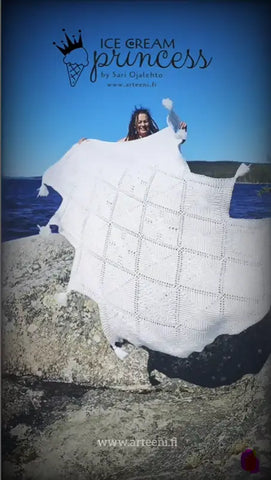
Ice Cream Princess is the perfect choice for all knitting enthusiasts looking for inspiration and new challenges. It is suitable for both experienced knitters and brave beginners, and offers endless possibilities for creativity.
There are more to come for Ice Cream Princess, and for the whole kingdom, as in addition to different Ice Cream Princess starts, there are plans for a smaller Ice Cream Prince and a larger Ice Cream Queen piece series, and of course their own projects.
Stay tuned!
Cotton Candy Princess KAL
Cotton Candy Princess is a delightful blend of cotton candy, princess, and knitting. The pattern features 8 charming sections of different surface knits, resulting in a semicircular scarf.
The knitting journey begins with an unprecedented start method from the center back of the scarf. Even experienced knitters won't be able to guess how the start was made after the fact. After the new start, we continue with one delightful surface knit pattern after another.

Arteeni's method vol1 and vol2
I love designing and knitting scarves without a plan. I've made so many scarves that I've had a couple of "aha" moments about how to make the start of a scarf from the neck even better. I made the first one years ago when my daughter was still little. I knitted her a beautiful lace scarf using this method. I didn't even have time to take proper pictures before the scarf got lost. But the method didn't disappear with it.
Arteeni's method is a great way to start a triangular scarf from the center back.
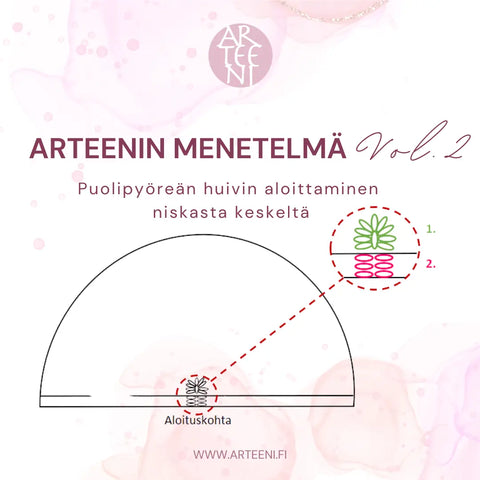
Arteeni's method vol.2 is very similar to the first method, but it's designed to start a semicircular scarf from the neck.
In both methods, the starting point is very subtle and neat. Some stitches are created for the edge (stockinette) of the scarf, and some for the body of the scarf itself.
Knit Scarves, with Special Double-Sidedness
Knitters and crocheters know the situation; you've made a beautiful... scarf, for example, and your good friend raises it to the front of their outstretched arms and admires it with lavish praise, saying how beautiful it is and how skilled you are... and they are looking at the messier wrong side of the scarf. It's nice to know that it's so beautiful, too, but...
Another familiar thing is when you accidentally wrap the scarf around your neck upside down. Or it just gets twisted so that you can only see the wrong side.
The solution: a scarf whose wrong side is just as pretty as the right side. I have already accumulated several of these, and more and more are coming!! Lieko, Kuulakka, Lá Breá, Pepple edge, Joy of Colors and Joy of Stripes, Senja...
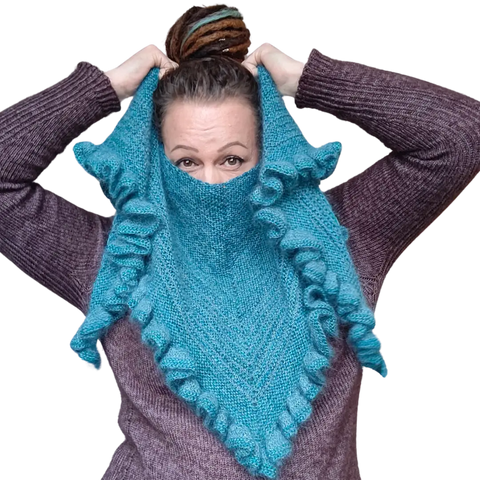
A couple of crochet patterns in an internationally acclaimed crochet book. Not much, but it's a start. Barahir ja Gilwen.
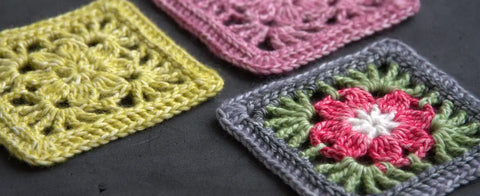
Elämä on runo - Life is a Poem KAL
After the Kalevala CAL project, I had the honor of designing a knitted patchwork quilt and a joint knitting event to celebrate Novita's 90th anniversary.
I took on the challenge with great pleasure and wanted to have symmetry in this one as well, instead of the usual bottom-up squares. The square should start from the middle. The only challenge is that the stitch is not square, but wider than higher, so the traditional "increase two stitches in each corner every other row" unfortunately is not enough to keep the square flat, but it curls up into a cup. Or, forced flat, the edge stitches stretch wider than the middle stitches.
So I created new increase methods for the pattern and also tips and tricks on how to tie and carry the yarns as neatly as possible in the corners of the piece. Seven different patterned squares, join and border. I feel joy and the thrill of success from designing this!
Elämä on runo - Life is a Poem.
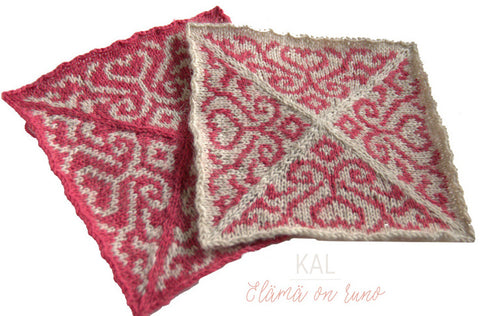

Photo Johanna Vaurio-Teräväinen
Taito magazine and Taitokeskus Projecst
I have had the honor of designing for Taito Magazine and Taitokeskus projects, including the Tähti poncho and leg warmers, Saara Hopea beret and mittens, the Helmi dress, and the Kuutar crocheted shawl.
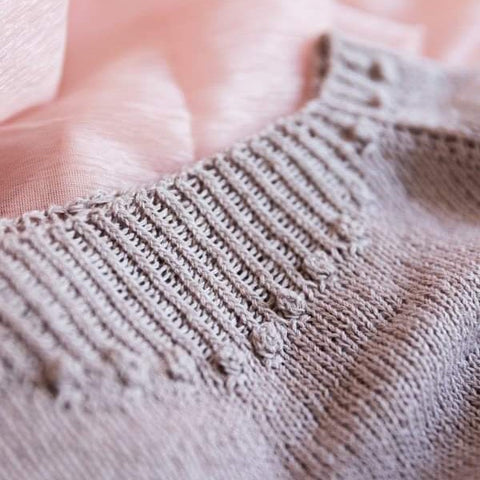 Helmililja Dress Collar Photo by Sonja Karlsson
Helmililja Dress Collar Photo by Sonja Karlsson
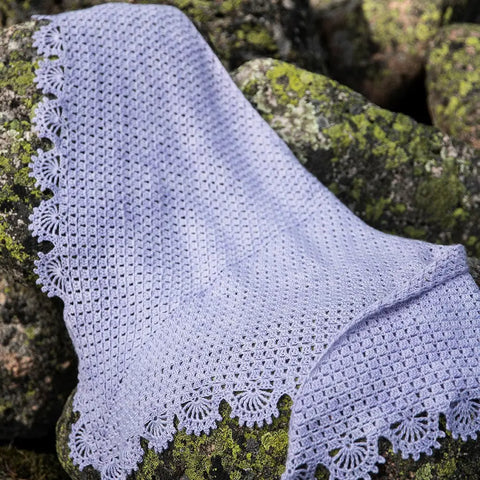 Kuutar Crocheted Shawl Photo by Sonja Karlsson
Kuutar Crocheted Shawl Photo by Sonja Karlsson
Courses and Events
I have taught several knitting and crocheting courses at Nurmijärvi Adult Education Center, organized craft retreats, given lectures and taught at events. Although public speaking and being in the spotlight have otherwise been somewhat difficult and challenging, I have enjoyed these situations a lot when it comes to handicrafts!
In the fall of 2024, I will be leading the professional and in-depth training "Hand Knitting Techniques (in Finnish)" at the Jyväskylä Taitokeskus, where I promise to take you a little deeper than the surface into the secrets, techniques, and stories of knitting. Will you join me?

More information and registration https://www.taito.fi/keskisuomi/taitokeskukset-ja-taito-shopit/jyvaskyla/
Galadriel CAL
The yarn store Lentävä Lapanen in Järvenpää invited me to design a joint crochet project after the Kalevala CAL. I love three-dimensional surfaces and raised patterns, which gave rise to the Galadriel crocheted patchwork quilt. This is still one of the most popular crochet patterns in my online store and has been crocheted all over the world.

Kalevala CAL
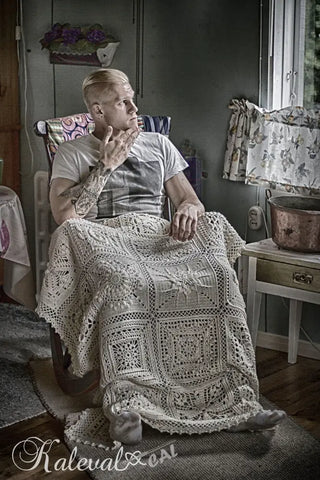
A labor of love that transformed Finnish crochet
The Kalevala CAL needs no introduction, but all the more reason to tell you something about its origins...
Through translating crochet instructions, I also had the opportunity to participate in an international crochet project, where crochet designers from around the world designed 12-inch crochet squares for the same joint crochet project. It didn't go well in many ways, and let's not dwell on that, but it sparked the idea that if we could harness the creativity and collaborative spirit of Finns, who knows what it could lead to. I pondered this in my mind and at some point I dared to say it out loud to my "translator-crochet-colleague" Milla (or maybe who said it first...), and she had had exactly the same thoughts. We immediately joined forces and decided to invest in one proper project rather than a couple of "so-so" projects.
We brainstormed the framework, square dimensions, yarn choices and everything possible for over six months just the two of us before we knew what we were doing and how. Then we started to gather volunteer designers, test crocheters and translators (seven different languages, wow!). The Kalevala CAL was selected by a top-notch group with such expertise, creativity and energy that it could only have a great outcome. Of course, managing the whole thing, being constantly available, guiding, delegating, clarifying and steering the group in the same direction took an unreasonable amount of time and energy, but it was worth it.
This project has certainly been under some kind of "guidance", as the first Ilmatar square was published on Ilmatar's Day, completely unplanned and by accident. Not everything went so well by accident, a lot of work was put into this.
My own and Milla's pride in this project is its very existence, the planning and execution of the entire project, but it could not have been done alone. Each of the dozens of volunteers has done their part of the whole.
My concrete contribution to this project is the Ilmatar square, the Väinämöinen join and the Pohjolan neito border. 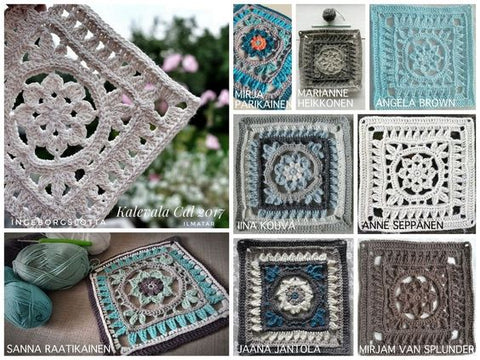
The Kalevala CAL blanket has probably changed the national identity of Finnish handicrafts and know-how, as the project was so well received and adopted as its own. Many have called it the master class of crocheting. It still lives strongly in people's minds - and on bed edges and sofa armrests - even after years.
Milla and I also had the honor of receiving the Noste award for leading the Kalevala CAL project and we were able to donate one blanket to the President's Couple Mäntyniemi with a small group. This will definitely stay in our own minds. An incredible project!!
Translation of Famous Crochet Projects
Life sometimes gives and sometimes takes. Sometimes the line between these is blurred. I fell ill with burnout and crocheting became a great source of joy in my everyday life. I was amazed at the amazing projects being done around the world, such as Dedri Uys' Sophie's Universe.
I heard about a new and wonderful blanket project called Mandala Madness designed by Helen Shrimpton and immediately thought it would be absolutely fantastic to make it available to Finnish people in their own language (I also encourage crocheting and knitting in English or other foreign languages, as it doesn't require much in the end, but gives and opens up the world a lot!).
I sent a message to Helen and asked for permission to translate the project. She directed me to the "translation group" package, and thus began the Finnish volunteer translation group. I called out and asked for volunteers on social media and gradually the group grew to even a few dozen. Countless crochet projects were translated into Finnish and, conversely, translations were obtained for countless projects in other languages.
Mandala Madness was the first translation and it was received with an unprecedented reception by the Finnish crochet audience. It's not just an old lady's thing and crocheting is much more than rose-patterned crocheted curtains in the kitchen window of a cottage.
As a result, the Finnish crochet world has never been the same again.
Lehmus and Aquila
One of the first "significant" aha-moments in my design career was the birth of the leaf pattern for the Lehmus shawl. I loved the Kiri shawl and all the leafy laces, but I was bothered by the fact that the leaves didn't continue perfectly in the more open lace pattern. Instead, there was usually one right stitch between the leaves in the vertical direction, which looked orphaned and lonely. So, hello, who thinks about individual pattern charts in such detail? Well, I do at least. Well, I had a strong image in my mind that it could be done so that a "3-together" stitch leaf stem runs vertically between the leaves, which would make the whole thing more serene and balanced. But it wasn't practically possible. I tried countless times and there were always too many stitches or something else strange happened, but the vision was so strong that I couldn't give up. Then one fine day it just clicked. Haa, the perfect leaf lace pattern was born, a balanced pattern with a leaf stem between the leaf patterns.
From the leaf pattern I designed the Lehmus, a triangle shawl started from the neck, which has been published in the online knitting magazine Ullan. It has gained great popularity around the world.
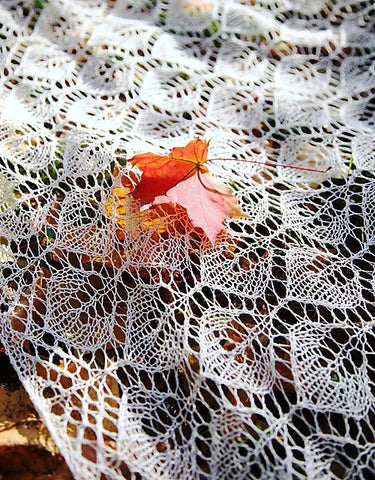
Along with the Lehmus shawl, a more open lace pattern was also born with the same idea, and from that came the Aquila -huivi, which can also be found on Ullan's website.
